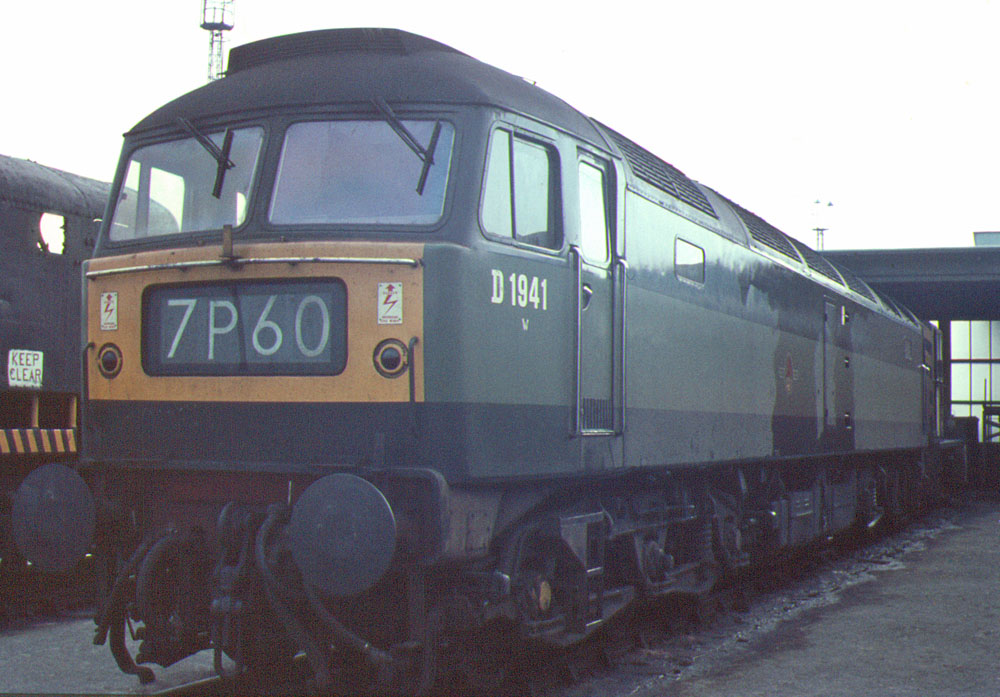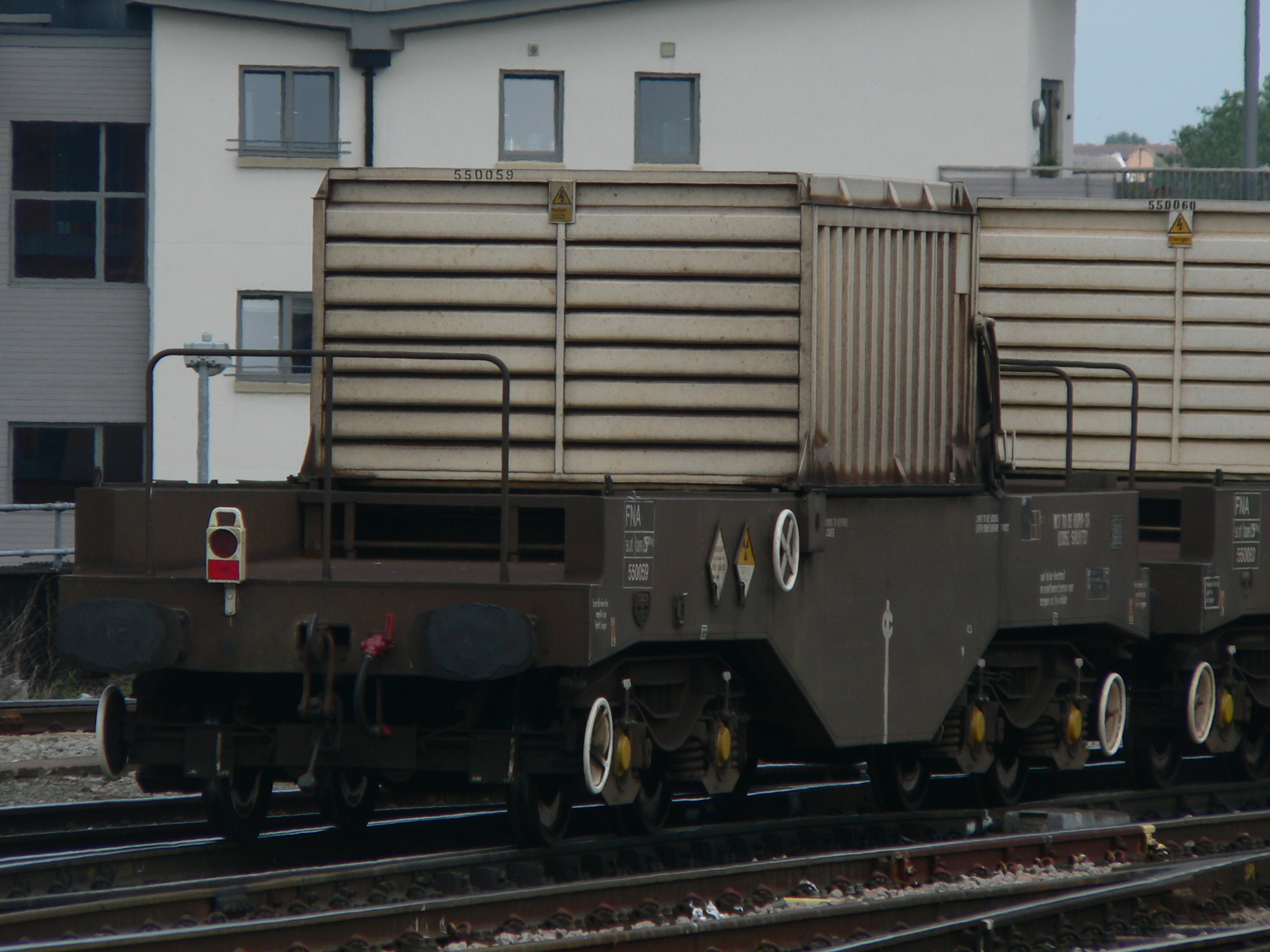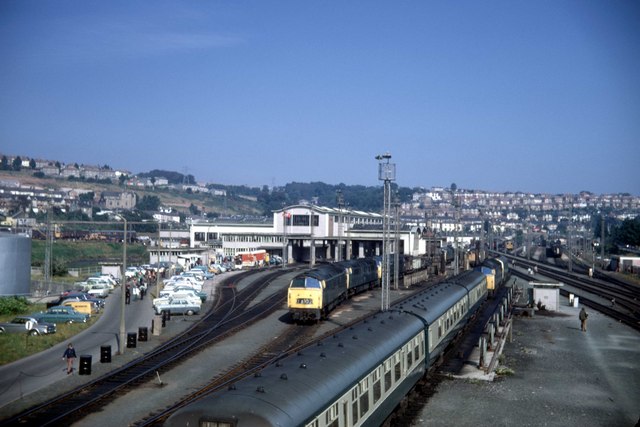|
British Rail Class 46
The British Rail Class 46 is a class of diesel locomotive. They were built from 1961 to 1963 at British Railways' Derby Works and were initially numbered D138–D193. With the arrival of TOPS they were renumbered to Class 46. Along with the similar Class 44 and 45 locomotives, they became known as ''Peaks''. Fifty-six locomotives were built. The first was withdrawn in 1977 and all were withdrawn by the end of 1984. Overview The Class 46 design was structurally the same as the preceding Class 45 build, and had the same Sulzer engine, but differed in the fitment of a Brush generator and traction motors, in place of the Crompton Parkinson equipment fitted to the Class 45. Along with the other Sulzer class 44 and 45 designs they are often referred to as "Peaks", so named because the earliest of the Class 44 were named after mountains. The British Transport Commission decided to cancel the final twenty Class 46 locomotives then on order and invited bids for twenty locomotives of ... [...More Info...] [...Related Items...] OR: [Wikipedia] [Google] [Baidu] |
British Railways
British Railways (BR), which from 1965 traded as British Rail, was a state-owned company that operated most of the overground rail transport in Great Britain from 1948 to 1997. It was formed from the nationalisation of the Big Four British railway companies, and was privatised in stages between 1994 and 1997. Originally a trading brand of the Railway Executive of the British Transport Commission, it became an independent statutory corporation in January 1963, when it was formally renamed the British Railways Board. The period of nationalisation saw sweeping changes in the railway. A process of dieselisation and electrification took place, and by 1968 steam locomotives had been entirely replaced by diesel and electric traction, except for the Vale of Rheidol Railway (a narrow-gauge tourist line). Passengers replaced freight as the main source of business, and one-third of the network was closed by the Beeching cuts of the 1960s in an effort to reduce rail subsidies. On privatis ... [...More Info...] [...Related Items...] OR: [Wikipedia] [Google] [Baidu] |
British Rail Class 47
The British Rail Class 47 or Brush Type 4 is a class of diesel-electric locomotive that was developed in the 1960s by Brush Traction. A total of 512 Class 47s were built at Brush's Falcon Works in Loughborough and at British Railways' Crewe Works between 1962 and 1968, which made them the most numerous class of British mainline diesel locomotive. They were fitted with the Sulzer 12LDA28C twin-bank twelve-cylinder unit producing though this was later derated to to improve reliabilityand have been used on both passenger and freight trains on Britain's railways for over 55 years. Despite the introduction of more modern types of traction, a significant number are still in use, both on the mainline and on heritage railways. As of December 2021, 78 locomotives still exist as Class 47s, including 31 which have been preserved. 33 further locomotives were converted to Class 57s between 1998 and 2004. Origins The Class 47 history begins in the early 1960s with the stated aim of ... [...More Info...] [...Related Items...] OR: [Wikipedia] [Google] [Baidu] |
Nuclear Flask
A nuclear flask is a shipping container that is used to transport active nuclear materials between nuclear power station and spent fuel reprocessing facilities. Each shipping container is designed to maintain its integrity under normal transportation conditions and during hypothetical accident conditions. They must protect their contents against damage from the outside world, such as impact or fire. They must also contain their contents from leakage, both for physical leakage and for radiological shielding. Spent nuclear fuel shipping casks are used to transport spent nuclear fuel used in nuclear power plants and research reactors to disposal sites such as the nuclear reprocessing center at COGEMA La Hague site. International United Kingdom Railway-carried flasks are used to transport spent fuel from nuclear power stations in the UK and the Sellafield spent nuclear fuel reprocessing facility. Each flask weighs more than 50 tonnes, and transports usually not more than 2.5 ton ... [...More Info...] [...Related Items...] OR: [Wikipedia] [Google] [Baidu] |
British Railways Mark 1
British Railways Mark 1 is the family designation for the first standardised designs of railway carriages built by British Railways (BR) from 1951 until 1974, now used only for charter services on the main lines or on preserved railways. Following nationalisation in 1948, BR had continued to build carriages to the designs of the "Big Four" companies (the Great Western, Southern, London, Midland and Scottish and London and North Eastern railways), and the Mark 1 was intended to be the standard carriage design for use across all lines, incorporating the best features of each of the former companies' designs. It was also designed to be much stronger than previous designs, to provide better protection for passengers in the event of a collision or derailment. The Mark 1 coaches were built in two distinct tranches: the early vehicles (1951–1960) and the 'Commonwealth' stock (named from the type of bogie used) from 1961 onwards. Construction The design was used for hauled passe ... [...More Info...] [...Related Items...] OR: [Wikipedia] [Google] [Baidu] |
Old Dalby Nuclear Flask Test-by-Brian-Robert-Marshall
Old or OLD may refer to: Places *Old, Baranya, Hungary *Old, Northamptonshire, England *Old Street station, a railway and tube station in London (station code OLD) *OLD, IATA code for Old Town Municipal Airport and Seaplane Base, Old Town, Maine, United States People *Old (surname) Music *OLD (band), a grindcore/industrial metal group *Old (Danny Brown album), ''Old'' (Danny Brown album), a 2013 album by Danny Brown *Old (Starflyer 59 album), ''Old'' (Starflyer 59 album), a 2003 album by Starflyer 59 *Old (song), "Old" (song), a 1995 song by Machine Head *''Old LP'', a 2019 album by That Dog Other uses *Old (film), ''Old'' (film), a 2021 American thriller film *''Oxford Latin Dictionary'' *Online dating *Over-Locknut Distance (or Dimension), a measurement of a Bicycle wheel#Construction, bicycle wheel and frame *Old age See also *List of people known as the Old * * *Olde, a list of people with the surname *Olds (other) {{disambiguation, geo ... [...More Info...] [...Related Items...] OR: [Wikipedia] [Google] [Baidu] |
Stoke-on-Trent
Stoke-on-Trent (often abbreviated to Stoke) is a city and Unitary authorities of England, unitary authority area in Staffordshire, England, with an area of . In 2019, the city had an estimated population of 256,375. It is the largest settlement in Staffordshire and is surrounded by the towns of Newcastle-under-Lyme, Alsager, Kidsgrove, Biddulph and Stone, Staffordshire, Stone, which form a conurbation around the city. Stoke is wikt:polycentric, polycentric, having been formed by Federation of Stoke-on-Trent, the federation of six towns in 1910. It took its name from Stoke-upon-Trent where the main centre of government and the principal Stoke-on-Trent railway station, railway station in the district were located. Hanley, Staffordshire, Hanley is the primary commercial centre; the other four towns which form the city are Burslem, Tunstall, Staffordshire, Tunstall, Longton, Staffordshire, Longton and Fenton, Staffordshire, Fenton. Stoke-on-Trent is the home of the pottery industr ... [...More Info...] [...Related Items...] OR: [Wikipedia] [Google] [Baidu] |
Cornwall
Cornwall (; kw, Kernow ) is a historic county and ceremonial county in South West England. It is recognised as one of the Celtic nations, and is the homeland of the Cornish people. Cornwall is bordered to the north and west by the Atlantic Ocean, to the south by the English Channel, and to the east by the county of Devon, with the River Tamar forming the border between them. Cornwall forms the westernmost part of the South West Peninsula of the island of Great Britain. The southwesternmost point is Land's End and the southernmost Lizard Point. Cornwall has a population of and an area of . The county has been administered since 2009 by the unitary authority, Cornwall Council. The ceremonial county of Cornwall also includes the Isles of Scilly, which are administered separately. The administrative centre of Cornwall is Truro, its only city. Cornwall was formerly a Brythonic kingdom and subsequently a royal duchy. It is the cultural and ethnic origin of the Cornish dias ... [...More Info...] [...Related Items...] OR: [Wikipedia] [Google] [Baidu] |
Laira TMD
Laira T&RSMD is a railway traction and rolling stock maintenance depot situated in Plymouth, Devon, England. The depot is operated by Great Western Railway and is mainly concerned with the overhaul and daily servicing of their fleet of High Speed Trains and also the DMUs used on local services. The depot code "LA" is used to identify rolling stock based there. After sixty years as a steam depot, servicing locomotives used on the Exeter to Plymouth line that runs past the shed as well as local lines, diesels started to arrive in 1958. A diesel depot opened in 1962 and was expanded in 1981 to accommodate the High Speed Trains. History Steam shed Laira was the location of the temporary terminus of the South Devon Railway from 5 May 1848 when a small engine shed would have been provided. With the completion of the line to Plymouth Millbay railway station on 2 April 1849 a new shed was provided there and the facilities at Laira dismantled, although it remained a junction f ... [...More Info...] [...Related Items...] OR: [Wikipedia] [Google] [Baidu] |
Laira Traction & Rolling Stock Maintenance Depot
Laira T&RSMD is a railway traction and rolling stock maintenance depot situated in Plymouth, Devon, England. The depot is operated by Great Western Railway and is mainly concerned with the overhaul and daily servicing of their fleet of High Speed Trains and also the DMUs used on local services. The depot code "LA" is used to identify rolling stock based there. After sixty years as a steam depot, servicing locomotives used on the Exeter to Plymouth line that runs past the shed as well as local lines, diesels started to arrive in 1958. A diesel depot opened in 1962 and was expanded in 1981 to accommodate the High Speed Trains. History Steam shed Laira was the location of the temporary terminus of the South Devon Railway from 5 May 1848 when a small engine shed would have been provided. With the completion of the line to Plymouth Millbay railway station on 2 April 1849 a new shed was provided there and the facilities at Laira dismantled, although it remained a junction for ... [...More Info...] [...Related Items...] OR: [Wikipedia] [Google] [Baidu] |
Gateshead TMD
Gateshead TMD was a railway traction maintenance depot situated in Gateshead, England. The depot code was 52A during the steam era and GD later on. It was known, along with the adjacent locomotive works, as Greenesfield or Greensfield, after a Mr. Greene, from whom the North Eastern Railway (NER) bought the land . In 1958, all BR locomotive depots on Tyneside, Wearside and in Northumberland became sub-sheds of Gateshead. The depot closed in 1991. Housing now occupies the site, now known as Ochre Yards. The street names reflect the site's history, with Worsdell Drive and Fletcher Road named after former locomotive superintendents of the NER. Engine shed and infrastructure The main shed housed four turntables for most of its working life. Prior to 1908, all four turntables had been 48' 5", which proved to be a problem as locomotives were steadily increasing in size. However, in that same year, the Redheugh Incline was closed, thereby allowing the track running alongsid ... [...More Info...] [...Related Items...] OR: [Wikipedia] [Google] [Baidu] |
Bristol Bath Road Depot
Bristol Bath Road depot was a railway traction maintenance depot in central Bristol, England, which was in use from 1852 until 1995. History The Bristol and Exeter Railway opened workshops at Bath Road in January 1852. 35 locomotives were built in the workshops between 1859 and 1876. Part of the site was an engine shed with six tracks. It was rebuilt under the Loans and Guarantees Act (1929) in 1934 by the Great Western Railway. The site's scale meant that although the depot was to be the major repair and maintenance point for the Bristol divisional area, the shed was restricted to a steel-frame straight 8-road with northernlight roof pattern form, as opposed to the GWR standard-pattern turntable model like Old Oak Common. Secondly, as the depot was so close to Bristol Temple Meads, it was required to keep the depot in full operation while construction took place. The twin-ramp coal stage was of standard GWR pattern but used concrete beams and brick piers to restrict ramp width. ... [...More Info...] [...Related Items...] OR: [Wikipedia] [Google] [Baidu] |
Ian Allan Publishing
Ian Allan Publishing was an English publisher, established in 1942, which specialised in transport books. It was founded by Ian Allan. In 1942 Ian Allan, then working in the public relations department for the Southern Railway at Waterloo station, decided he could deal with many of the requests he received about rolling stock by collecting the information into a book. The result was his first book, ''ABC of Southern Locomotives''. This proved to be a success, contributing to the emergence of trainspotting as a popular hobby in the UK, and leading to the formation of the company.Ian Allan…the man who launched a million locospotters ''The Railway Magazine'' issue 1174 February 1999 pages 20-27 The company grew from a small producer of books for train enthusiasts and spotters to a large transport publisher. Each year it published books covering subjects such as military and civil aviation, naval and maritime topics, buses, trams, trolleybuses and steam railways, including hi ... [...More Info...] [...Related Items...] OR: [Wikipedia] [Google] [Baidu] |
.jpg)
.jpg)







